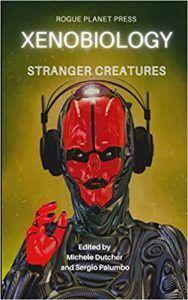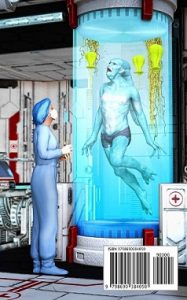
© Rogue Planet Press
A 7000-word story of mine called The Nuclei has just appeared in a new collection called Xenobiology: Stranger Creatures. Its subtitle describes it as ‘an anthology of international sci-fi, steampunk and urban fantasy short stories.’
The contents of the anthology are explained in more detail in its introduction by one of its editors, Michele Dutcher: “Since Xenobiology is not a study of naturally occurring organisms, the stories in this anthology deal with biology that has been artificially produced, or biological creatures that have been produced by genetic material being acted upon by outside sources to produce something new. Those new organisms can be intriguing when thrown into the mind of an imaginative author.”
The Nuclei is classifiable as science fiction but definitely lurks at the horror end of the sci-fi spectrum. Therefore, in Xenobiology: Stranger Creatures, it’s credited to Jim Mountfield, the pseudonym I use for my macabre fiction. Basically, it’s a body-horror story set in Edinburgh after an apocalypse. Now there’s a sentence you don’t get to write too often.
Writing a story with a post-apocalyptic setting was an opportunity for me to address some of the misconceptions people have about what would happen after civilisation collapsed, thanks to watching many Hollywood movies on the theme.
Firstly, and I say this with regret because I’m a big fan of George Miller’s Mad Max franchise, petrol would soon degrade and become unusable. Thus, within a few years, no survivors would be able to drive around in motorised vehicles – not even in the giant armoured battle-trucks that featured in 2015’s Mad Max: Fury Road. So in The Nuclei I have the human protagonists riding about on horses or on bicycles. The bicycles possess solid wheels made of micro closed-cell polymer resin that allow them to be rode over the debris-strewn, weed-sprouting streets of post-apocalyptic Edinburgh without the risk of incurring punctures. Also, importantly, when the bicycles aren’t on the road, they’re ‘connected to motors and chargers and used to repower the batteries for essentials like the field radio.’
The story also makes references to a few things that seem too mundane to appear in the average post-apocalyptic movie but that would surely be a big thing for survivors of a real-life global meltdown. For example, scurvy would manifest itself among those survivors if they were suddenly denied access to fruit and vegetables in their diets. And the danger posed by cuts and infections would be immense after whatever supplies of antibiotics had survived the apocalypse ran out.
One crucial point that the story tries to make is that post-apocalypse the remaining humans wouldn’t immediately degenerate into bands of savages hellbent on killing each other. This departs from the anarchic scenarios depicted in Cormac McCarthy’s 2006 novel The Road and or in just about every zombie-holocaust movie ever made (the latter suggesting that, when it comes down to it, human beings are even worse than any zombies they’re trying to fight off).
Actually – as reports from the aftermath of any earthquake, tsunami or other natural disaster will testify – human beings are genetically programmed to cooperate and help one another out. This is not for any uplifting moral reason but simply because cooperation increases their chances of survival. Hence, in The Nuclei, you get the members of a loopy post-apocalyptic religious cult joining forces with a militia dedicated to the protection of medical science in order to defeat, or at least diminish, a common foe.
And what is that foe? Well, it’s one of the ‘stranger creatures’ of the collection’s title, the result of genetic tampering. It’s also the result of me sitting down and attempting to imagine the most revolting monster possible.
Xenobiology: Stranger Creatures is currently available from Amazon here.

© Rogue Planet Press
